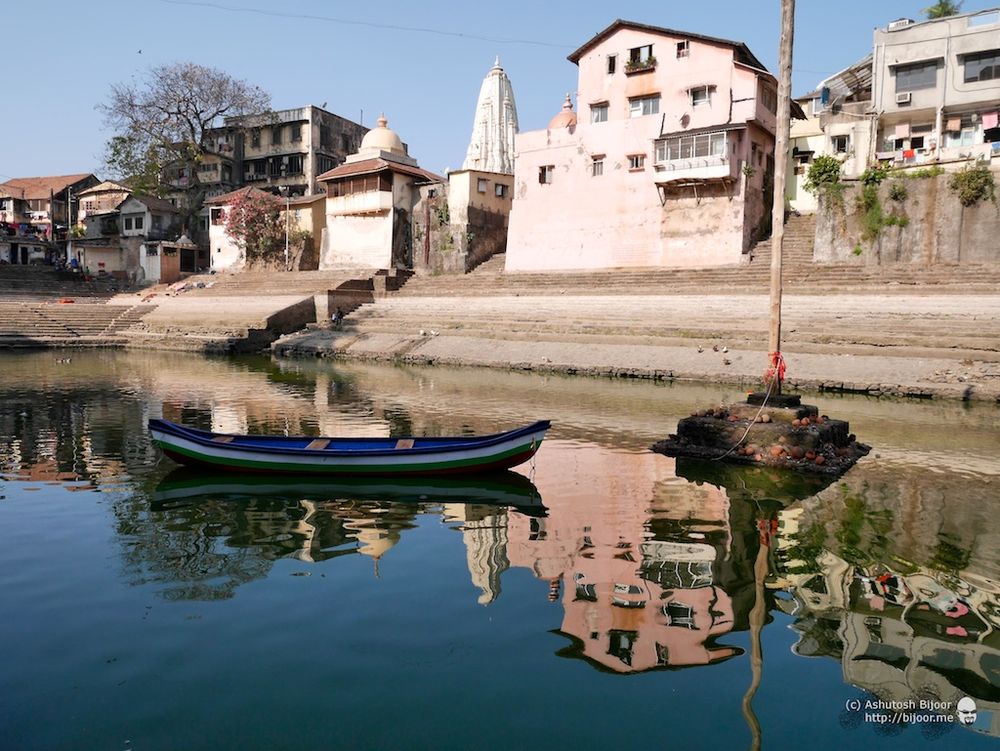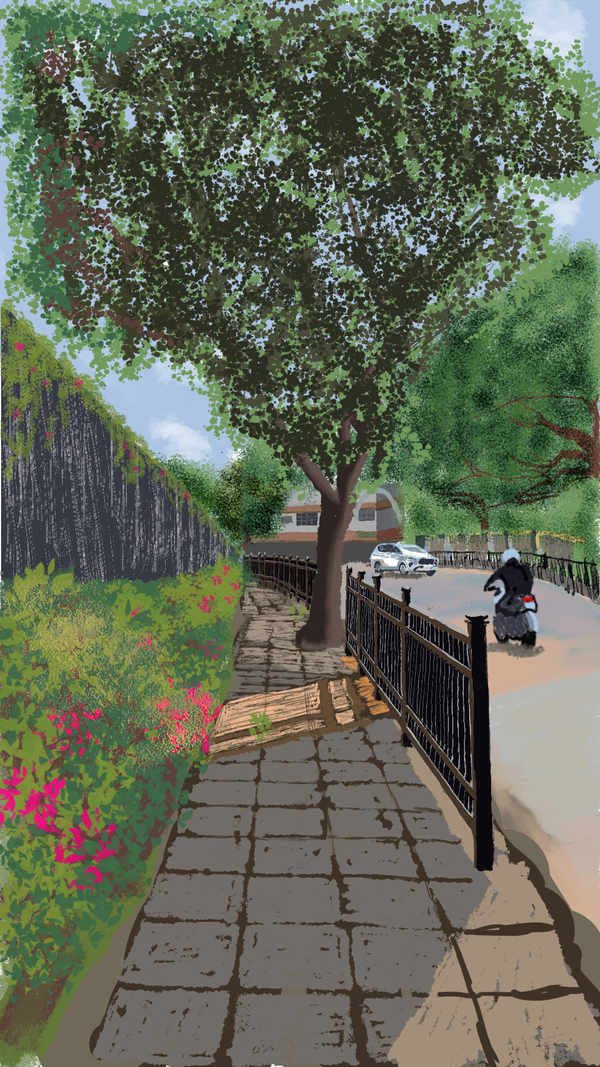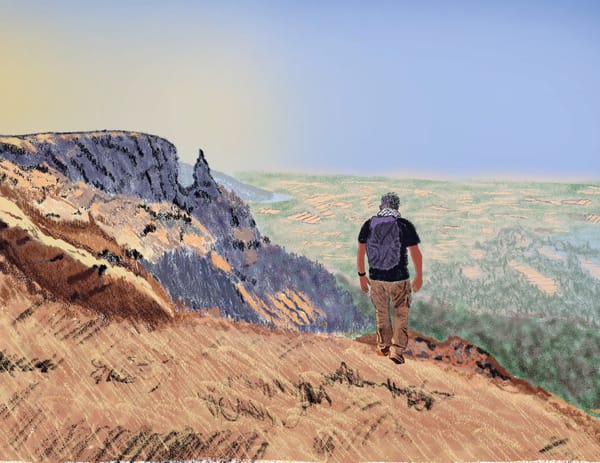Cycling to Banganga Tank and Walkeshwar Temple
Banganga Tank is one of the oldest sweet water tanks located in Mumbai. Before Mumbai got water supply from the Vihar and Tulsi lakes, the only source of water were several tanks built within the city. There were eleven tanks in all, of which Banganga is the only tank that has been present since ancient times. It is a great destination for a weekend cycle ride. The distance from Andheri to Banganga is just over 25 km one way.
 Located on the western end of the Back Bay – the largest bay in Mumbai, on the slopes of the Malabar Hill – the highest point on the island, Banganga Tank is a sweet water tank located very close to the sea shore
Located on the western end of the Back Bay – the largest bay in Mumbai, on the slopes of the Malabar Hill – the highest point on the island, Banganga Tank is a sweet water tank located very close to the sea shore
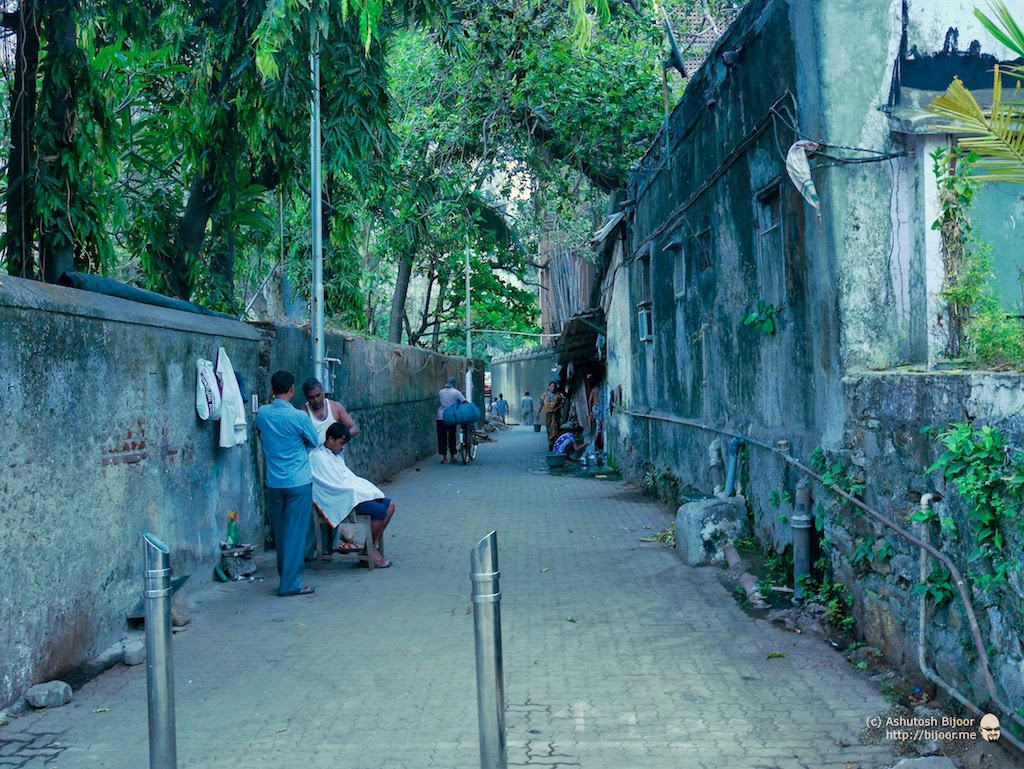 The access to the tank and the temple is through narrow lanes lined with old houses that seem to stand still in history. One of the favorite destinations for several cyclists, I had visited Banganga several times with friends before, but never really paid attention to it’s historical significance.
The access to the tank and the temple is through narrow lanes lined with old houses that seem to stand still in history. One of the favorite destinations for several cyclists, I had visited Banganga several times with friends before, but never really paid attention to it’s historical significance.
 Legend has it that the tank originated when Rama and Laxmana stopped by on their way to Lanka to rescue Sita. Rama was thirsty and shot an arrow (baan) into the ground, and magically a spring of fresh water burst forth, apparently from an underground tributary of the holy Ganges – and hence the name Baan-Ganga (ref)
Legend has it that the tank originated when Rama and Laxmana stopped by on their way to Lanka to rescue Sita. Rama was thirsty and shot an arrow (baan) into the ground, and magically a spring of fresh water burst forth, apparently from an underground tributary of the holy Ganges – and hence the name Baan-Ganga (ref)
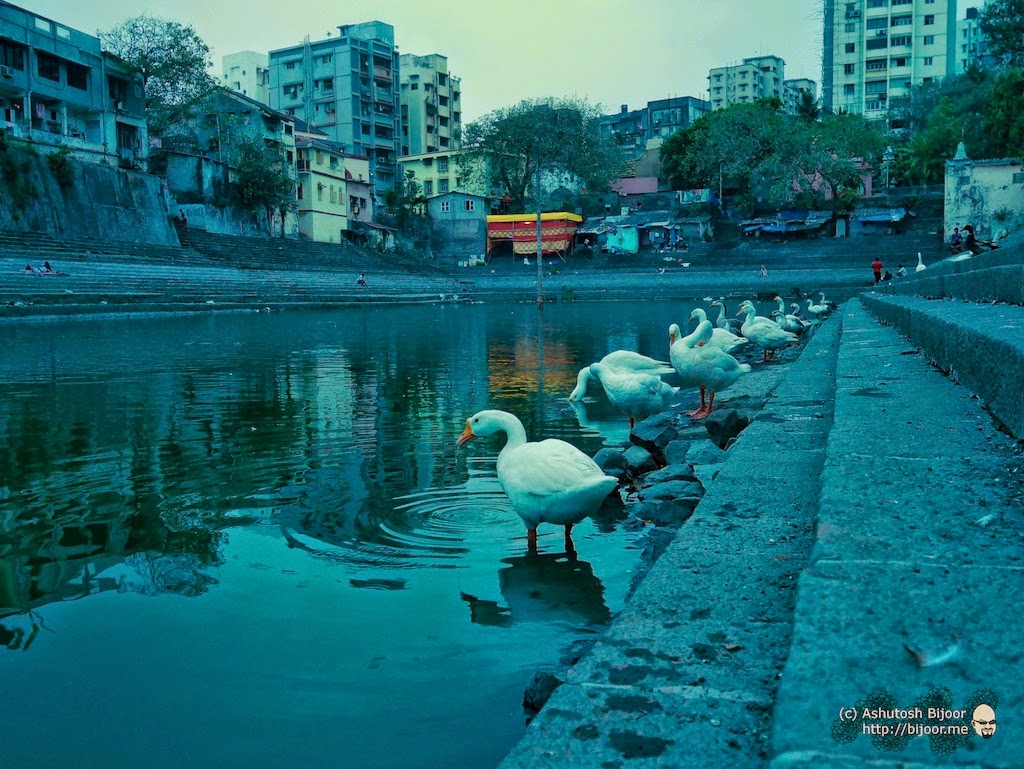 The cool water of the tank is home to several geese and ducks, who are fed scraps of food by pilgrims visiting the tank and the Walkeshwar Temple located on its banks
The cool water of the tank is home to several geese and ducks, who are fed scraps of food by pilgrims visiting the tank and the Walkeshwar Temple located on its banks
 The best time to ride to Banganga is early morning, to arrive around dawn, before the crowds descend here to visit the Walkeshwar Temple. I sat for a while on the shore, watching the ducks swimming lazily around in the tank, before I started exploring the various historical aspects of the place
The best time to ride to Banganga is early morning, to arrive around dawn, before the crowds descend here to visit the Walkeshwar Temple. I sat for a while on the shore, watching the ducks swimming lazily around in the tank, before I started exploring the various historical aspects of the place
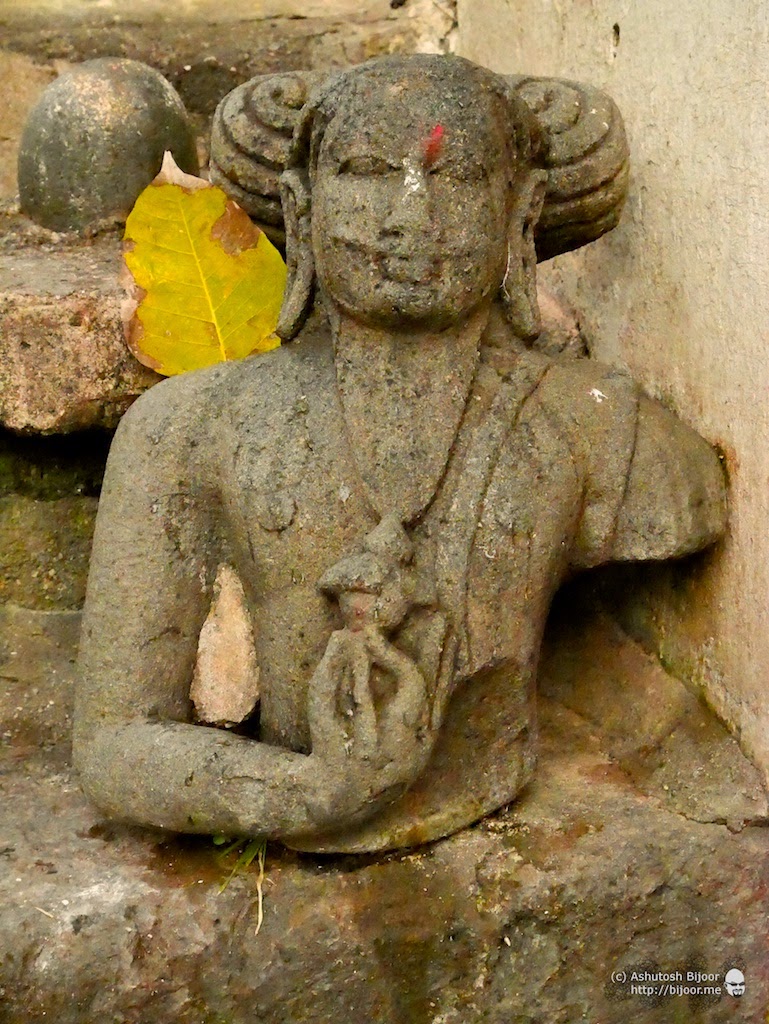 The first known historical reference of this site is from the Shilahara dynasty that ruled northern Konkan including Mumbai, with their capital in Thane. In 1127 AD, Lakshman Prabhu, a minister in the court of King Aparaka I was commissioned to build the tank and the neighboring temple. This statue seems to be of a devotee meditating in the Pushan Mudra – with the right hand showing the thumb touching the index and middle finger. The left hand in the mudra has the thumb touching the ring and middle finger – would have been nice if both hands were still in tact.
The first known historical reference of this site is from the Shilahara dynasty that ruled northern Konkan including Mumbai, with their capital in Thane. In 1127 AD, Lakshman Prabhu, a minister in the court of King Aparaka I was commissioned to build the tank and the neighboring temple. This statue seems to be of a devotee meditating in the Pushan Mudra – with the right hand showing the thumb touching the index and middle finger. The left hand in the mudra has the thumb touching the ring and middle finger – would have been nice if both hands were still in tact.
 The Shilahara administration was very methodical. Hinduism, Buddhism and Jainism were all living side by side in the Silahara districts very amicably, but the Silaharas themselves were Hindus (ref). The left panel above seems to depict Hanuman, the monkey god and his army. The panel to the right with three standing figures with folded hands is a pattern that is found in other panels too. Curious to know the significance.
The Shilahara administration was very methodical. Hinduism, Buddhism and Jainism were all living side by side in the Silahara districts very amicably, but the Silaharas themselves were Hindus (ref). The left panel above seems to depict Hanuman, the monkey god and his army. The panel to the right with three standing figures with folded hands is a pattern that is found in other panels too. Curious to know the significance.
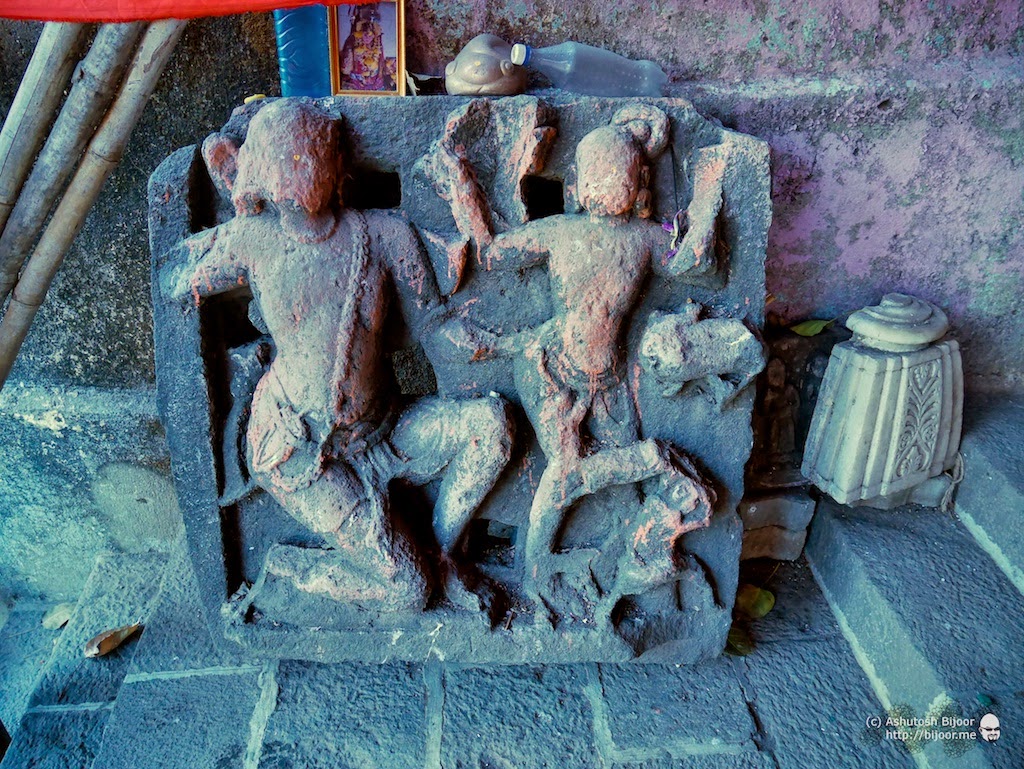 This carving lying on the steps on the southern bank seems to depict a scene. Could it be that the figure on the left is that of Lord Rama holding a bow in the left hand and the right hand reaching out for an arrow in his quiver for shooting the arrow in the ground? That would be quite a significant testimonial to the legend of Banganga!
This carving lying on the steps on the southern bank seems to depict a scene. Could it be that the figure on the left is that of Lord Rama holding a bow in the left hand and the right hand reaching out for an arrow in his quiver for shooting the arrow in the ground? That would be quite a significant testimonial to the legend of Banganga!
 A broken panel that must have been exquisitely carved, but unfortunately in a severely damaged condition just lies on the steps unattended and forlorn. The stone on the right is so incongruous primarily because the dress worn seems to be very unlike an Indian garment.
A broken panel that must have been exquisitely carved, but unfortunately in a severely damaged condition just lies on the steps unattended and forlorn. The stone on the right is so incongruous primarily because the dress worn seems to be very unlike an Indian garment.
 This is another one of the same pattern of three standing figures with folded hands. Am yet to find its significance despite having searched quite desperately for any reference online
This is another one of the same pattern of three standing figures with folded hands. Am yet to find its significance despite having searched quite desperately for any reference online
 Though quite disintegrated, this figure of a person with folded hands seems to be in a similar pose as the three standing figures in other panels
Though quite disintegrated, this figure of a person with folded hands seems to be in a similar pose as the three standing figures in other panels
 This panel seems to be of a woman and a child. This panel like some others seem to be very roughly carved and hence probably belong to a different era than the more exquisitely carved artifacts.
This panel seems to be of a woman and a child. This panel like some others seem to be very roughly carved and hence probably belong to a different era than the more exquisitely carved artifacts.
 On one corner of the tank, there is a boat lying against the wall. Presumably used to clean the tank by the care takers, the boat makes a striking picture with the painted cutout of Goddess Durga behind, along with some tins and bins.
On one corner of the tank, there is a boat lying against the wall. Presumably used to clean the tank by the care takers, the boat makes a striking picture with the painted cutout of Goddess Durga behind, along with some tins and bins.
 Several of the hero or memorial stones (thanks PN Subramaniam) are covered in the typical red sindoor or vermilion. The original practice is to apply sindoor on the idol of Hanuman – the monkey God. The legend is that one day Hanuman noticed Sita wearing the red powder in the parting of her hair, and asked what it was. Sita explained that it was sindoor and that it blessed Lord Rama with a long and prosperous life. Shortly thereafter, Lord Rama saw Hanuman covered from head to toe with sindoor and asked the reason. Hanuman replied that if just a pinch of sindoor on Sita’s head can bless Lord Rama with a long and happy life, he would cover his entire body and bless Lord Rama with eternal bliss. It is now a practice to apply sindoor to idols of Hanuman. This is also called as Chola Chandana. People take back a little sindoor from the idol and wear it on their foreheads. (ref)
Several of the hero or memorial stones (thanks PN Subramaniam) are covered in the typical red sindoor or vermilion. The original practice is to apply sindoor on the idol of Hanuman – the monkey God. The legend is that one day Hanuman noticed Sita wearing the red powder in the parting of her hair, and asked what it was. Sita explained that it was sindoor and that it blessed Lord Rama with a long and prosperous life. Shortly thereafter, Lord Rama saw Hanuman covered from head to toe with sindoor and asked the reason. Hanuman replied that if just a pinch of sindoor on Sita’s head can bless Lord Rama with a long and happy life, he would cover his entire body and bless Lord Rama with eternal bliss. It is now a practice to apply sindoor to idols of Hanuman. This is also called as Chola Chandana. People take back a little sindoor from the idol and wear it on their foreheads. (ref)
 There are several temples on the eastern and western side of the tank, and two large Deepastambh – pillars with lights – at the southern end. One can walk around the tank and visit all the temples as this couple and their dog is doing early today morning
There are several temples on the eastern and western side of the tank, and two large Deepastambh – pillars with lights – at the southern end. One can walk around the tank and visit all the temples as this couple and their dog is doing early today morning
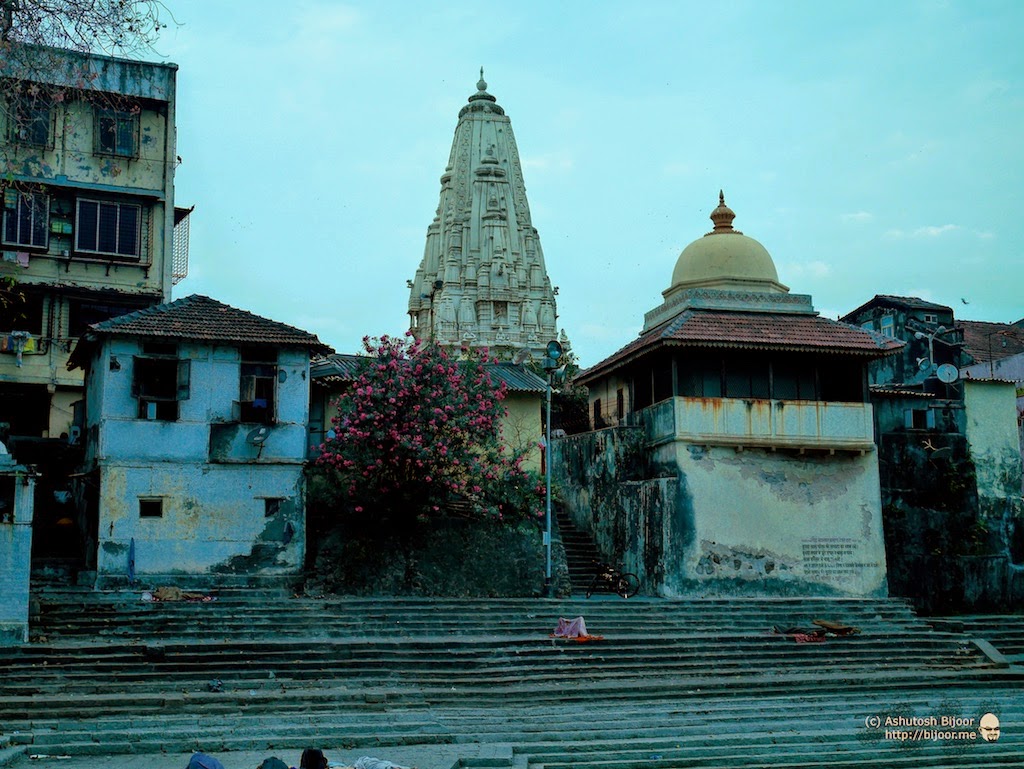 The oldest temple is the one shown in this picture. The plaque inside the temple indicates that it is the “Rameshwar Temple”, built in 1842 AD. However, it has also been referred to as the Walkeshwar temple (See picture below).
The oldest temple is the one shown in this picture. The plaque inside the temple indicates that it is the “Rameshwar Temple”, built in 1842 AD. However, it has also been referred to as the Walkeshwar temple (See picture below).
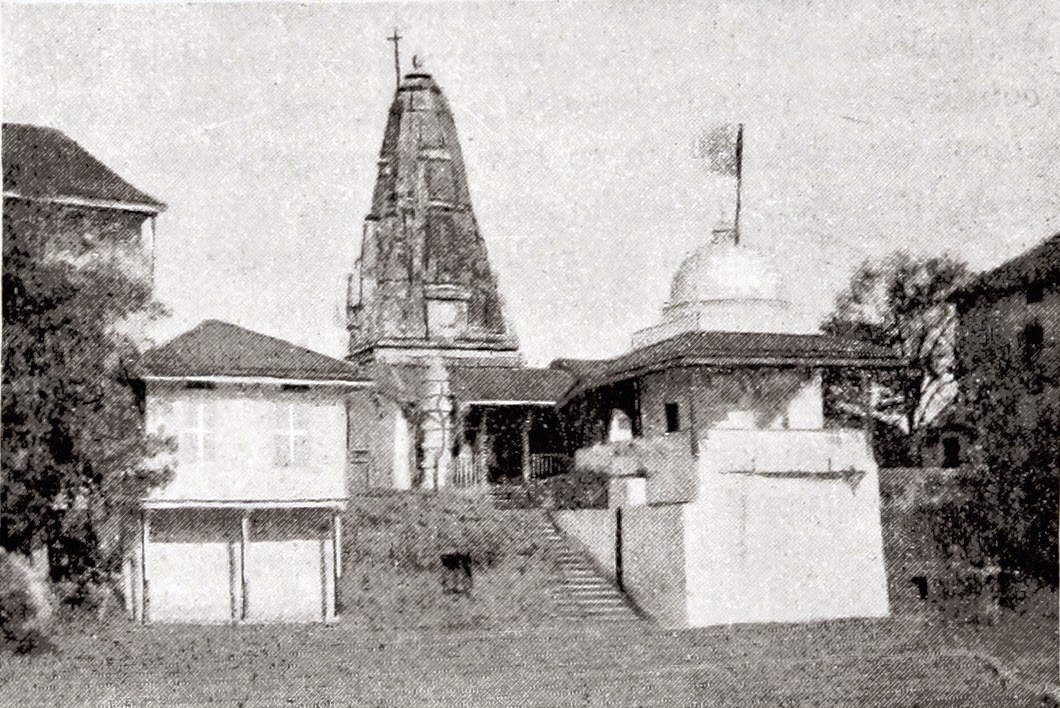 This is a picture dated in 1893 AD of the same temple, from a similar angle taken from the book “Bombay and Western India. A series of stray papers” by James Douglas (copyrights: The British Library @ Flickr Commons, ref). The smaller temple to the right is the Ganapati Temple.
This is a picture dated in 1893 AD of the same temple, from a similar angle taken from the book “Bombay and Western India. A series of stray papers” by James Douglas (copyrights: The British Library @ Flickr Commons, ref). The smaller temple to the right is the Ganapati Temple.
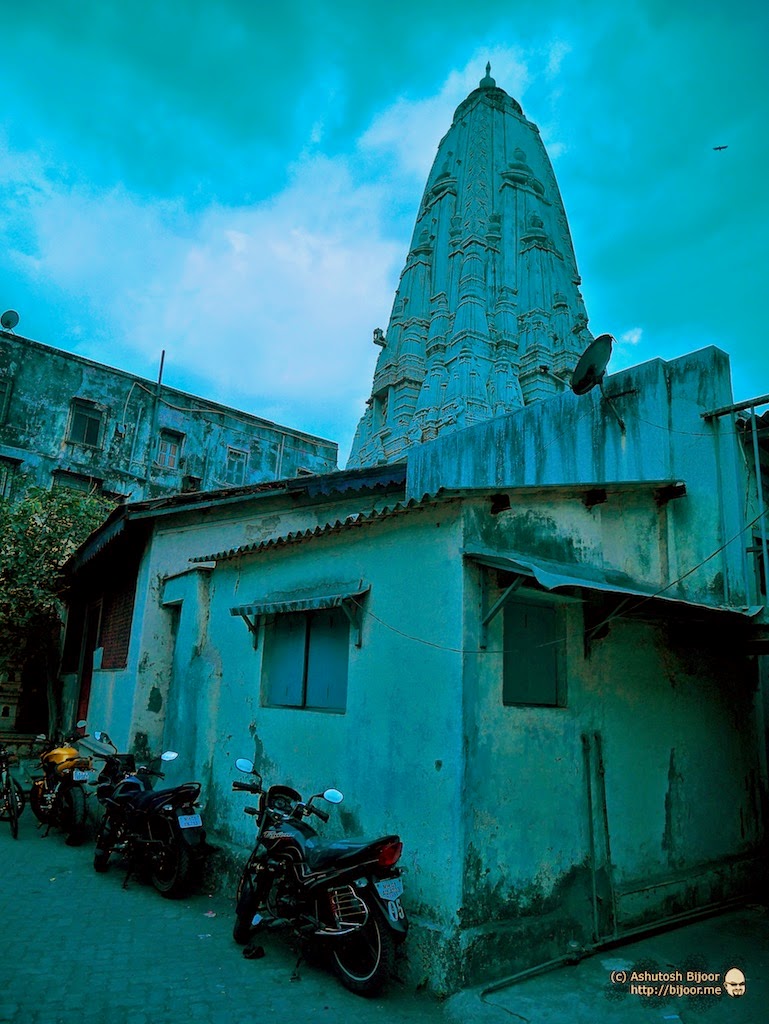
 Both the temples can be accessed from the small road that circles around the tank. The original temple was destroyed by the Portuguese during their reign over Mumbai in the 16th century. It was rebuilt due to the generosity of Mumbai businessman and philanthropist, Rama Kamath, a Gaud Saraswat Brahmin (known in British records as ‘Kamati’) in 1715. The main temple has been substantially reconstructed and many smaller temples have come up around the Banganga Tank (ref)
Both the temples can be accessed from the small road that circles around the tank. The original temple was destroyed by the Portuguese during their reign over Mumbai in the 16th century. It was rebuilt due to the generosity of Mumbai businessman and philanthropist, Rama Kamath, a Gaud Saraswat Brahmin (known in British records as ‘Kamati’) in 1715. The main temple has been substantially reconstructed and many smaller temples have come up around the Banganga Tank (ref)
 There is a legend that Lord Rama constructed a Shiva Lingam out of sand – hence the name was derived from Vaaluka (sand) Ishwar (Shiva) as Valukeshwar – or the anglicized Walkeshwar
There is a legend that Lord Rama constructed a Shiva Lingam out of sand – hence the name was derived from Vaaluka (sand) Ishwar (Shiva) as Valukeshwar – or the anglicized Walkeshwar
 The Ganapati temple on the opposite side of the street has an intricately carved doorway that looks straight into the doorway of the Rameshwar temple. The Ganapati idol inside is of marble and not of stone as I had expected. Ganapati (or Ganesh) is the favorite God of Mumbai and Ganesh Chaturthi – is celebrated all over the city for 10 days, culminating on Ananth Chaturdashi (fourteenth day of the waxing moon period) when scores of people take to the streets to bid farewell to the God and immerse the large idols in the sea
The Ganapati temple on the opposite side of the street has an intricately carved doorway that looks straight into the doorway of the Rameshwar temple. The Ganapati idol inside is of marble and not of stone as I had expected. Ganapati (or Ganesh) is the favorite God of Mumbai and Ganesh Chaturthi – is celebrated all over the city for 10 days, culminating on Ananth Chaturdashi (fourteenth day of the waxing moon period) when scores of people take to the streets to bid farewell to the God and immerse the large idols in the sea

 The other big temple also on the western bank is more popularly called as the Walkeshwar temple now, seems to be a much more recent construction of bricks and concrete.
The other big temple also on the western bank is more popularly called as the Walkeshwar temple now, seems to be a much more recent construction of bricks and concrete.

 Another temple that seems to be quite old, but undated is the Siddheshwar temple on the eastern bank, located in the courtyard that overlooks the tank. I could not enter the temple because there was a man fast asleep at the entrance, and I had no intention of waking him up for my exploration.
Another temple that seems to be quite old, but undated is the Siddheshwar temple on the eastern bank, located in the courtyard that overlooks the tank. I could not enter the temple because there was a man fast asleep at the entrance, and I had no intention of waking him up for my exploration.
This picture taken from the western bank shows the entrance to the Sidddheshwar temple above with two small pillars, towards the right of the photograph. On the left, the dome peeping out above the houses belongs to “Sri Ventakesh Balaji Temple” that is purportedly constructed in 1789 AD as per the board at its entrance.
 Compare this photograph to the one above. This is a photograph dated 1855 AD, from the ‘Vibart Collection of Views in South India’ taken by an unknown photographer (ref). Both, the Siddheshwar temple to the right as well as the Venkatesh temple to the left seem to have been present in the same locations.
Compare this photograph to the one above. This is a photograph dated 1855 AD, from the ‘Vibart Collection of Views in South India’ taken by an unknown photographer (ref). Both, the Siddheshwar temple to the right as well as the Venkatesh temple to the left seem to have been present in the same locations.
 This watercolor painting is by William Carpenter (1818-1899) between 1850 and 1856. Inscribed on the reverse and on the mount is: ‘Walkeshwur’ (ref). Interestingly, there seems to have been another entrance to the tank from the eastern side.
This watercolor painting is by William Carpenter (1818-1899) between 1850 and 1856. Inscribed on the reverse and on the mount is: ‘Walkeshwur’ (ref). Interestingly, there seems to have been another entrance to the tank from the eastern side.
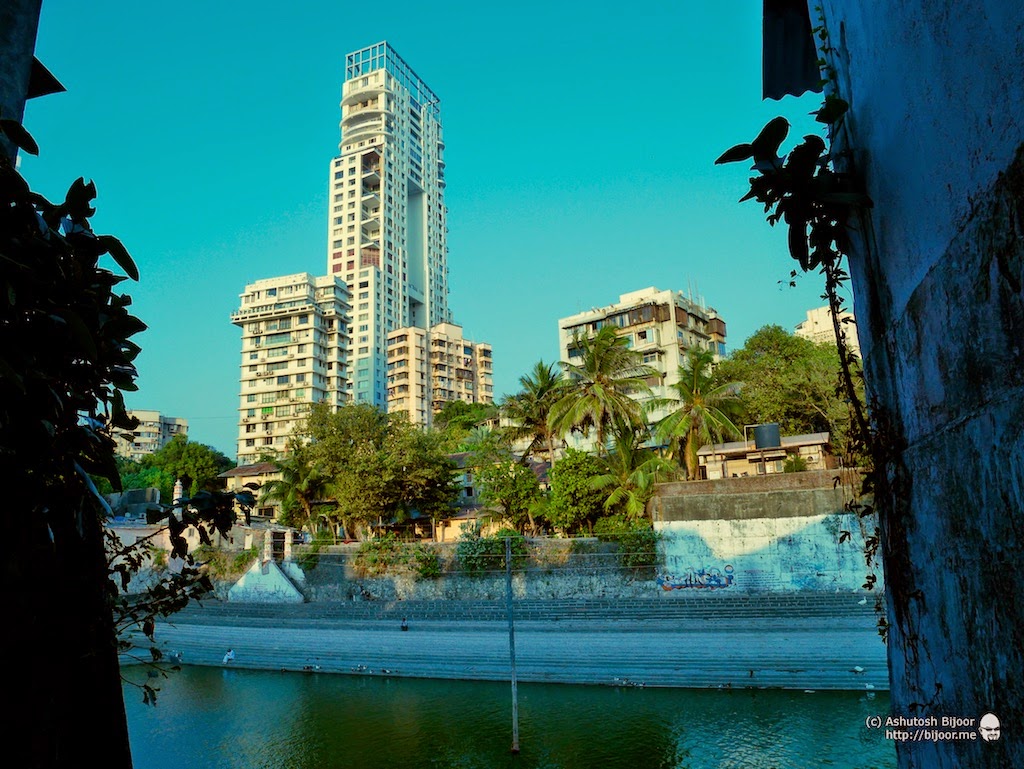 This is my approximation of the viewpoint in the painting taken from the western bank looking at the eastern bank. Tried to coordinate the two small pillars of the Siddheshwar temple on the left of the painting.
This is my approximation of the viewpoint in the painting taken from the western bank looking at the eastern bank. Tried to coordinate the two small pillars of the Siddheshwar temple on the left of the painting.
Here is another old photo of a temple located on the steps leading up from the south eastern corner of the tank up to the Banganga Cross Lane. The photo is from the ‘Vibart Collection of Views in South India’ taken by an unknown photographer about 1860 (ref)
 Compare the previous photo with this one that I took of the same temple. Though the temple is still in the same state, the residential buildings around it have expanded and consumed some part of the stairs. A board on the temple front names it as the Jabreshwar Mahadev Temple. But it is also variously referred to as the Walkeshwar Temple
Compare the previous photo with this one that I took of the same temple. Though the temple is still in the same state, the residential buildings around it have expanded and consumed some part of the stairs. A board on the temple front names it as the Jabreshwar Mahadev Temple. But it is also variously referred to as the Walkeshwar Temple
 The name Jabreshwar seems to be composed of Jabar and Ishvara. Jabar means strong or huge (ref) and Ishvara means the supreme lord (ref)
The name Jabreshwar seems to be composed of Jabar and Ishvara. Jabar means strong or huge (ref) and Ishvara means the supreme lord (ref)
 The inside of the temple is very well maintained and is painted gaily with all the carvings kept clean with a daily morning wash.
The inside of the temple is very well maintained and is painted gaily with all the carvings kept clean with a daily morning wash.

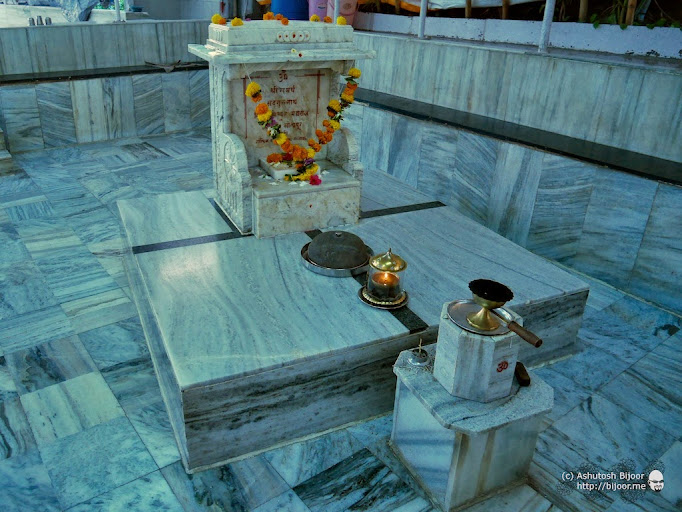 There is a small lane leading from the north west corner of Banganga to a Hindu crematorium. Adjoining the crematorium is the samadhi of the spiritual guru Shree Siddharameshwar Maharaj (1888–1936) and his disciples (ref)
There is a small lane leading from the north west corner of Banganga to a Hindu crematorium. Adjoining the crematorium is the samadhi of the spiritual guru Shree Siddharameshwar Maharaj (1888–1936) and his disciples (ref)
 The view from behind the samadhi looks out into the sea, and in the evening presents a hypnotic view of the sunset. The photographs in this article were taken across three visits, the last of which was in the evening – and that’s how I captured this sunset.
The view from behind the samadhi looks out into the sea, and in the evening presents a hypnotic view of the sunset. The photographs in this article were taken across three visits, the last of which was in the evening – and that’s how I captured this sunset.
I had ridden to Banganga several times before, but this effort of researching and documenting it’s history has revealed a completely different picture of the significance of this place. Don’t miss reading the article about the Ambernath Temple – that was also built by the Shilaharas.

